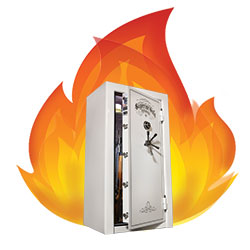Do You Need Fire Protection?
 Papers and documents char at temperatures around 405°F. Guns are damaged by temperatures exceeding 500°F. To protect documents and other possessions during a home fire, the internal temperature of a safe should remain below 350°F. This is why we include Superior Fire Protection standard on all models–so your safe’s contents will be protected from fire as well as theft.
Papers and documents char at temperatures around 405°F. Guns are damaged by temperatures exceeding 500°F. To protect documents and other possessions during a home fire, the internal temperature of a safe should remain below 350°F. This is why we include Superior Fire Protection standard on all models–so your safe’s contents will be protected from fire as well as theft.
FIRE PROTECTION RATING
GR Series: 60 minutes at 1200°F
FIRE PROTECTION DETAILS
A safe’s fire resistance depends on four main variables:
Gypsum is the most commonly used material in home safes. When heated to 262°F it releases water vapor, which cools the safe’s interior. Until the moisture is baked out of the gypsum the interior temperature of a safe will remain in the 200°F to 300°F range. Multiple layers of gypsum provide longer and higher ratings.
2. How Well the Fire Insulation Is Installed
The inside of the safe should be fully covered with fire insulation—no bare metal or hinge pocket cutouts.
Heat causes metal distortion. Temperatures above 1000°F quickly distort thin, light-weight doors in only minutes, causing premature fire seal failure.
4. Door Seal Effectiveness
Intumescent (heat-expanding) fire seals, when heated above 300°F, can expand up to ten times their original thickness, sealing out heat. Intumescent seals are essential for achieving ratings of over an hour. Rope or other types of seals are not as effective.
